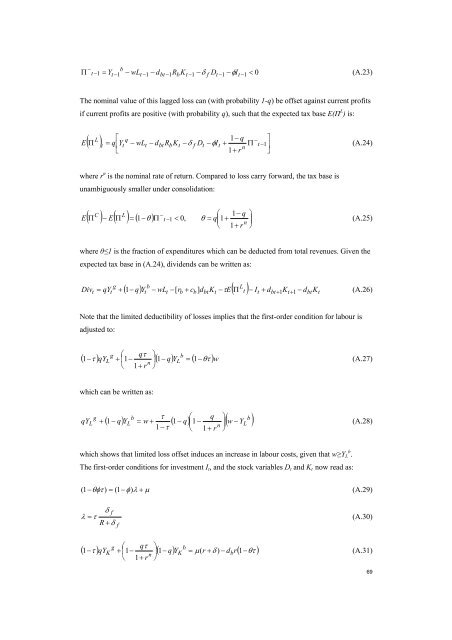The economic effects of EU-reforms in corporate income tax systems
The economic effects of EU-reforms in corporate income tax systems
The economic effects of EU-reforms in corporate income tax systems
You also want an ePaper? Increase the reach of your titles
YUMPU automatically turns print PDFs into web optimized ePapers that Google loves.
− b<br />
Π t −1 = Yt<br />
−1<br />
− wLt<br />
−1<br />
− dbt<br />
−1Rb<br />
Kt<br />
−1<br />
−δ f Dt<br />
−1<br />
−φIt<br />
−1<br />
< 0<br />
(A.23)<br />
<strong>The</strong> nom<strong>in</strong>al value <strong>of</strong> this lagged loss can (with probability 1-q) be <strong>of</strong>fset aga<strong>in</strong>st current pr<strong>of</strong>its<br />
if current pr<strong>of</strong>its are positive (with probability q), such that the expected <strong>tax</strong> base E(П L ) is:<br />
E<br />
L ⎡ q<br />
1−<br />
q ⎤<br />
( Π ) = q Y − wL − d R K − D −φI<br />
+ Π<br />
− t − 1 ⎥ ⎦<br />
t<br />
⎢<br />
⎣<br />
t<br />
t<br />
bt<br />
b<br />
t<br />
δ f t t<br />
(A.24)<br />
n<br />
1+<br />
r<br />
where r n is the nom<strong>in</strong>al rate <strong>of</strong> return. Compared to loss carry forward, the <strong>tax</strong> base is<br />
unambiguously smaller under consolidation:<br />
E<br />
C L<br />
−<br />
⎛ 1−<br />
q ⎞<br />
( Π ) − E( Π ) = ( 1−<br />
) Π t −1 < 0, θ = q⎜1+<br />
⎟<br />
⎠<br />
θ (A.25)<br />
n<br />
⎝ 1+<br />
r<br />
where θ≤1 is the fraction <strong>of</strong> expenditures which can be deducted from total revenues. Given the<br />
expected <strong>tax</strong> base <strong>in</strong> (A.24), dividends can be written as:<br />
Div<br />
b<br />
( − q) Yt<br />
− wLt<br />
−[<br />
rb<br />
+ cb<br />
] dbtKt<br />
− E( Π<br />
L t ) − It<br />
+ dbt+ 1Kt<br />
1 − dbtKt<br />
g<br />
t = qYt<br />
+<br />
+<br />
1 τ (A.26)<br />
Note that the limited deductibility <strong>of</strong> losses implies that the first-order condition for labour is<br />
adjusted to:<br />
⎛ qτ<br />
⎞<br />
1 L<br />
n L<br />
(A.27)<br />
⎝ 1+<br />
r ⎠<br />
g<br />
b<br />
( −τ<br />
) qY + ⎜1−<br />
⎟( 1−<br />
q) Y = ( 1−θτ<br />
)w<br />
which can be written as:<br />
qY<br />
g<br />
L<br />
+<br />
b τ ⎛ q ⎞ b<br />
( 1−<br />
q) Y = w + ( 1−<br />
q) ⎜1<br />
− ⎟( w − Y )<br />
L<br />
1−τ<br />
⎝<br />
1+<br />
r<br />
n<br />
⎠<br />
L<br />
(A.28)<br />
which shows that limited loss <strong>of</strong>fset <strong>in</strong>duces an <strong>in</strong>crease <strong>in</strong> labour costs, given that w≥Y b L .<br />
<strong>The</strong> first-order conditions for <strong>in</strong>vestment I t , and the stock variables D t and K t now read as:<br />
( 1− θφτ ) = (1 −φ)<br />
λ + µ<br />
(A.29)<br />
δ f<br />
λ = τ<br />
(A.30)<br />
R + δ<br />
f<br />
⎛ qτ<br />
⎞<br />
K K<br />
b<br />
(A.31)<br />
n<br />
⎝ 1+<br />
r ⎠<br />
g<br />
b<br />
( 1−τ<br />
) qY + ⎜1−<br />
⎟( 1−<br />
q) Y = µ ( r + δ ) − d r( 1−θτ<br />
)<br />
69
















